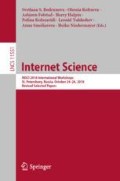Abstract
Neural network-based Open-ended conversational agents automatically generate responses based on predictive models learned from a large number of pairs of utterances. The generated responses are typically acceptable as a sentence but are often dull, generic, and certainly devoid of any emotion. In this paper we present neural models that learn to express a given emotion in the generated response. We propose four models and evaluate them against 3 baselines. An encoder-decoder framework-based model with multiple attention layers provides the best overall performance in terms of expressing the required emotion. While it does not outperform other models on all emotions, it presents promising results in most cases.
Access this chapter
Tax calculation will be finalised at checkout
Purchases are for personal use only
References
Bahdanau, D., Cho, K., Bengio, Y.: Neural machine translation by jointly learning to align and translate. arXiv:1409.0473 (2014)
Bessho, F., Harada, T., Kuniyoshi, Y.: Dialog system using real-time crowdsourcing and Twitter large-scale corpus. In: Proceedings of the Annual Meeting of the Special Interest Group on Discourse and Dialogue, pp. 227–231. Association for Computational Linguistics (2012)
Bickmore, T.W., Picard, R.W.: Establishing and maintaining long-term human-computer relationships. ACM Trans. Comput.-Hum. Interact. 12(2), 293–327 (2005). https://doi.org/10.1145/1067860.1067867
Ekman, P., Friesen, W.V., Ellsworth, P.: Emotion in the Human Face: Guide-Lines for Research and an Integration of Findings. Pergamon, Oxford (1972)
Graves, A., Fernández, S., Schmidhuber, J.: Bidirectional LSTM networks for improved phoneme classification and recognition. In: Duch, W., Kacprzyk, J., Oja, E., Zadrożny, S. (eds.) ICANN 2005. LNCS, vol. 3697, pp. 799–804. Springer, Heidelberg (2005). https://doi.org/10.1007/11550907_126
Hochreiter, S., Schmidhuber, J.: Long short-term memory. Neural Comput. 9(8), 1735–1780 (1997)
Huang, C., Zaiane, O., Trabelsi, A., Dziri, N.: Automatic dialogue generation with expressed emotions. In: Proceedings of the Conference of the North American Chapter of the Association for Computational Linguistics, vol. 2, pp. 49–54 (2018). https://doi.org/10.18653/v1/n18-2008
Joulin, A., Grave, E., Bojanowski, P., Douze, M., Jégou, H., Mikolov, T.: Fasttext.zip: compressing text classification models. arXiv:1612.03651 (2016)
Kingma, D.P., Ba, J.: Adam: a method for stochastic optimization. arXiv:1412.6980 (2014)
Li, J., Galley, M., Brockett, C., Spithourakis, G., Gao, J., Dolan, B.: A persona-based neural conversation model. In: Proceedings of the Annual Meeting of the Association for Computational Linguistics, vol. 1, pp. 994–1003 (2016). https://doi.org/10.18653/v1/p16-1094
Li, J., Monroe, W., Jurafsky, D.: Data distillation for controlling specificity in dialogue generation. arXiv:1702.06703 (2017)
Li, J., Monroe, W., Ritter, A., Galley, M., Gao, J., Jurafsky, D.: Deep reinforcement learning for dialogue generation. arXiv preprint arXiv:1606.01541 (2016). https://doi.org/10.18653/v1/d16-1127
Li, J., Monroe, W., Shi, T., Ritter, A., Jurafsky, D.: Adversarial learning for neural dialogue generation. arXiv:1701.06547 (2017). https://doi.org/10.18653/v1/d17-1230
Lin, Z., et al.: A structured self-attentive sentence embedding. arXiv:1703.03130 (2017)
Lison, P., Tiedemann, J.: OpenSubtitles 2016: extracting large parallel corpora from movie and TV subtitles (2016)
Luong, T., Pham, H., Manning, C.D.: Effective approaches to attention-based neural machine translation. In: Proceedings of the 2015 Conference on Empirical Methods in Natural Language Processing, pp. 1412–1421 (2015). https://doi.org/10.18653/v1/d15-1166
Mikolov, T., Sutskever, I., Chen, K., Corrado, G.S., Dean, J.: Distributed representations of words and phrases and their compositionality. In: Advances in Neural Information Processing Systems, pp. 3111–3119 (2013)
Mintz, M., Bills, S., Snow, R., Jurafsky, D.: Distant supervision for relation extraction without labeled data. In: Proceedings of the Joint Conference of the 47th ACL and the 4th AFNLP, vol. 2, pp. 1003–1011 (2009). https://doi.org/10.3115/1690219.1690287
Mohammad, S.M.: # emotional tweets. In: Proceedings of the 1st Joint Conference on Lexical and Computational Semantics, Proceedings of the Main Conference and the Shared Task, Proceedings of the 6th International Workshop on Semantic Evaluation, vols. 1, 2, pp. 246–255 (2012)
Parrott, W.G.: Emotions in Social Psychology: Essential Readings. Psychology Press, London (2001)
Ritter, A., Cherry, C., Dolan, W.B.: Data-driven response generation in social media. In: Proceedings of the Conference on Empirical Methods in Natural Language Processing, pp. 583–593. Association for Computational Linguistics (2011)
Scherer, K.R., Wallbott, H.G.: Evidence for universality and cultural variation of differential emotion response patterning. J. Pers. Soc. Psychol. 66(2), 310 (1994). https://doi.org/10.1037/0022-3514.67.1.55
Serban, I.V., et al.: A hierarchical latent variable encoder-decoder model for generating dialogues. In: AAAI, pp. 3295–3301 (2017). https://doi.org/10.21437/interspeech.2017-628
Shahraki, A.G., Zaiane, O.R.: Lexical and learning-based emotion mining from text. In: Proceedings of CICLing (2017)
Shaver, P., Schwartz, J., Kirson, D., O’Connor, C.: Emotion knowledge: further exploration of a prototype approach. J. Pers. Soc. Psychol. 52(6), 1061 (1987). https://doi.org/10.1037/0022-3514.52.6.1061
Silva, J., Coheur, L., Mendes, A.C., Wichert, A.: From symbolic to sub-symbolic information in question classification. Artif. Intell. Rev. 35(2), 137–154 (2011). https://doi.org/10.1007/s10462-010-9188-4
Sutskever, I., Vinyals, O., Le, Q.V.: Sequence to sequence learning with neural networks. In: Advances in Neural Information Processing Systems, pp. 3104–3112 (2014)
Vaswani, A., et al.: Attention is all you need. In: Advances in Neural Information Processing Systems, pp. 5998–6008 (2017)
Vinyals, O., Le, Q.: A neural conversational model. arXiv:1506.05869 (2015)
Xu, W., Rudnicky, A.I.: Task-based dialog management using an agenda. In: Proceedings of the 2000 ANLP/NAACL Workshop on Conversational systems, vol. 3, pp. 42–47. Association for Computational Linguistics (2000). https://doi.org/10.3115/1117562.1117571
Yadollahi, A., Shahraki, A.G., Zaiane, O.R.: Current state of text sentiment analysis from opinion to emotion mining. ACM Comput. Surv. (CSUR) 50(2), 25 (2017). https://doi.org/10.1145/3057270
Zhou, H., Huang, M., Zhang, T., Zhu, X., Liu, B.: Emotional chatting machine: emotional conversation generation with internal and external memory. In: Proceedings of the AAAI Conference on Artificial Intelligence (2018)
Zhou, P., Qi, Z., Zheng, S., Xu, J., Bao, H., Xu, B.: Text classification improved by integrating bidirectional LSTM with two-dimensional max pooling. arXiv:1611.06639 (2016)
Author information
Authors and Affiliations
Corresponding author
Editor information
Editors and Affiliations
Rights and permissions
Copyright information
© 2019 Springer Nature Switzerland AG
About this paper
Cite this paper
Huang, C., Zaïane, O.R. (2019). Generating Responses Expressing Emotion in an Open-Domain Dialogue System. In: Bodrunova, S., et al. Internet Science. INSCI 2018. Lecture Notes in Computer Science(), vol 11551. Springer, Cham. https://doi.org/10.1007/978-3-030-17705-8_9
Download citation
DOI: https://doi.org/10.1007/978-3-030-17705-8_9
Published:
Publisher Name: Springer, Cham
Print ISBN: 978-3-030-17704-1
Online ISBN: 978-3-030-17705-8
eBook Packages: Computer ScienceComputer Science (R0)

